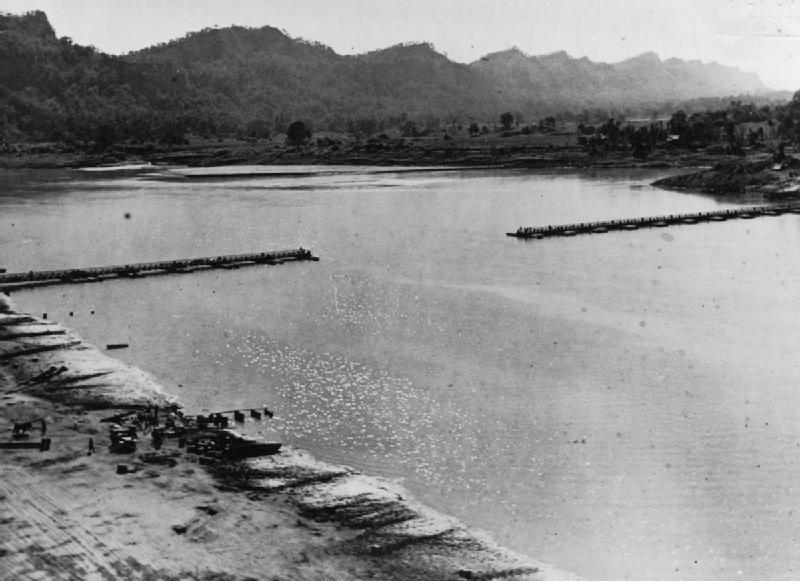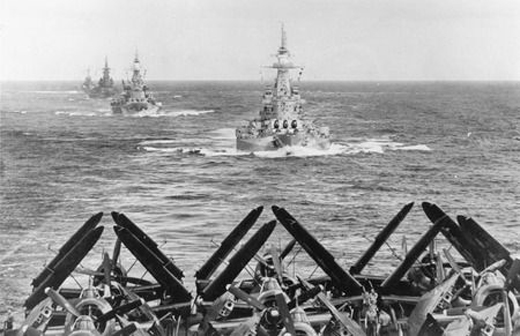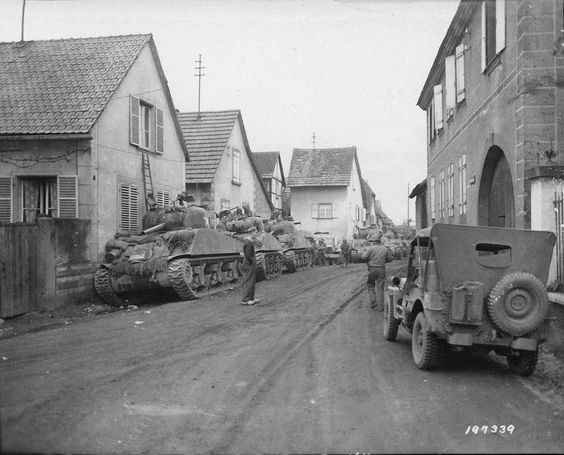Air Operations, CBI
BURMA- 10 10th Air Force B-25s attack rail and road bridges at 3 locations.
- 60 10th Air Force fighter-bombers attack troops, tanks, defended areas, and dumps at 8 locations.
- 40 fighter-bombers support Allied ground forces in the Bhamo area.
- 16 P-47s attack a supply train at Pangkyawng and sweep the rail lines between Hsipaw and Lashio.
- 14th Air Force B-25s attack Hsenwi.
- 14th Air Force fighter-bombers attack various targets in eastern Burma.
- A small number of 14th Air Force fighter-bombers attack various targets around Chiuchiang and between Paoching and Yungfengshih.
- A 311th Fighter Group P-51 downs a twin-engine bomber near Pengpu at 1215 hours.
Air Operations, East Indies
- FEAF B-24s and B-25s attack the Boroboro and Kendari airfields on Celebes.
- B-25s attack the Namlea airfield on Boeroe and shipping near Ceram.
Air Operations, Europe
RAF BOMBER COMMANDDaylight Ops:
- 93 Lancasters of No. 3 Group attack the Hansa benzol plant at Dortmund through thick cloud. The bombing is believed to have been accurate.
- There are no losses.
- 1 Hudson makes a Resistance flight.
- 504 aircraft including 394 Halifaxes, 87 Lancasters and 23 Mosquitos of Nos. 1, 4, 6 and 8 Groups are sent to bomb Hagen. The town of Hagen was not too heavily bombed before this raid. The effect upon industrial production is serious. Many firms are recorded as having lost up to 3 months' production. In addition, it was found by the Allies after the war that a factory making U-boat accumulator batteries - of which large numbers are needed by the new types of U-boats - is completely destroyed in this raid.
- 1 Halifax and 1 Lancaster crash in France.
- 66 Mosquitos are sent to Giessen, 10 Stirlings are on Resistance operations, and there are 62 Mosquito patrols and 44 RCM sorties.
- 1 Stirling on a Resistance flight and 1 Mosquito Intruder are lost.
GERMANY:
- 129 1st Bomb Division B-17s attack a marshalling yard at Oberlahnstein.
- 135 2nd Bomb Division B-24s attack a marshalling yard at Bingen.
- 160 3rd Bomb Division B-17s abort due to bad weather.
- 11 B-24s are downed by Luftwaffe fighters west of the Rhine River; no losses among the 436 VIII Fighter Command escorts.
- 133 VIII Fighter Command fighters sweep areas of western Germany.
- 4 fighters are lost.
- 8th and 9th Air Force fighter pilots down 36 Luftwaffe aircraft over Germany between 1135 and 1525 hours.
GERMANY:
- 210 9th Bomb Division bombers attack three defended towns is western Germany.
- 9th Air force fighters and fighter-bombers attack marshalling yards and bridges, and support US Army ground forces, especially the US 1st Army units battling in the Huertgen Forest area.
ITALY:
- 12th Air Force medium bombers attack at least six bridges.
- XXII TAC P-47s support US Army ground forces.
- During the night, XXII TAC A-20s attack light sources throughout the Po River valley.
AUSTRIA:
- 15th Air Force B-17s and B-24s attack an oil refinery at Vienna and an oil refinery at Strasshof.
- 15th Air Force heavy bombers attack a highway bridge.
- 15th Air Force B-17s and B-24s attack oil-industry targets at Odertal and Blechhammer.
- 15th Air Force heavy bombers attack a marshalling yard at Celldomolk.
Air Operations, Philippines
- FEAF B-24s attack the Cagayan and Matina airfields on Mindanao and the Dumagueta airfield on Negros.
- 7 V Fighter Command P-40 fighter-bombers support US Army ground forces on Leyte.
- V Fighter Command fighter-bombers attack various targets in the central Philippines and southern Luzon.
Air Operations, Volcano Islands
23 30th Heavy Bomb Group B-24s based on Guam attack Iwo Jima.
[Burma
In the British XXXIII Corps sector, the 11th East African Div reaches the Chindwin River at Kalewa.
[China
A Japanese column advancing on Kweiyang reaches and occupies Tu-shan.
The Americans suggest to Chiang Kai-shek that he should arm 3 Communist regiments in Shen-si province, the first region to be administered by the Communists. The 3 regiments would be employed in Nationalist territory under American officers. The Generalissimo refuses.
[Diplomatic Relations
De Gaulle arrives in Moscow for meetings with Stalin.
[Eastern Front
In Czechoslovakia, the 4th Ukraine Front extends its bridgehead over the Ondava.
In Hungary, the 2nd Ukraine Front attacks the strong enemy fortifications in the Miskolc area, while the 3rd Ukraine Front and formations of partisans force the Germans back on a broad front between the Danube and the Drava, south of Lake Balaton.
SOUTHERN SECTORWith the threat of a Soviet breakthrough in Hungary the Germans bring the 2nd Panzer Army back into the line, deploying it south of Lake Balaton. The main objective for the army is the protection of the Hungarian oilfields at Nagykanitza.
North of the lake Army Group South deploys Fretter Pico's 6th Army between the lake and the Hatvan with the III Panzer, LXXII and LVII Panzer Corps, while the 8th Army under Wohler is around Miskolc.
[Italy
Filippo Marinetti, founder of the 'Futurist' art movement in 1909 and a leading Fascist author, dies at the age of 67.
British 8th Army units begin probing actions before an all-out offensive.
[Pacific
- The Japanese coast defense vessel No. 64 is sunk by the US submarine Pipefish (SS-388) in the South China Sea.
- The US submarine Sea Devil (SS-400) attacks a Japanese convoy in the East China Sea sinking the merchant tanker Akigawa Maru (6859t) and passenger/cargo ship Hawaii Maru (9467t) about 80 miles south-southwest of Kyushu.
- The British submarine Sturdy sinks the Japanese Communication Ship No.142 in Makassar Strait.
Philippines
On Leyte the 1st Battalion, 34th Infantry Regiment, and the 2nd Battalion, 19th Infantry Regiment, capture the Japanese defensive line at Kilay Ridge. The Japanese lose 900 killed.
Groups of American destroyers shell the Japanese positions at Palompon, on the west coast of Leyte, and in Ormoc Bay. 4 destroyers which entered Ormoc Bay by night are engaged by Japanese aircraft, destroyers and coast defense batteries. The American destroyer Cooper (DD-695) is sunk and the destroyers Allen M. Sumner (DD-692) and Moale (DD-693) are damaged. The Japanese destroyer Kuwa is sunk.
[Western Front
The Germans blow up a dyke on the lower Rhine near Arnhem, flooding the region southwest of Armhem and forcing the Canadian II Corps, 1st Army, to withdraw from their bridgeheads over the Waal.
With the fall of Dreisbach, Gen Patton's 3rd Army has completed the capture of its sector west of the Saar; during the night, in the XX Corps sector, the 90th Div crosses the river in the area of Dillingen and the 95th opposite Saarlautern, where there is bitter house-to-house fighting, and the 5th Div crosses the western border of the Houve forest. The XII Corps crosses the Saar near Saar-Union. Gen Jacob Devers, Commander of the 6th Army Group, orders the US 7th Army to concentrate and re-group by December 5, the date for which an important attack to the north is planned. The Colmar sector is entrusted to the only French troops in the 1st Army, joined by the French 2nd Arm Div, detached from the US 7th Army. The 44th and 45th Divs, XV Corps, US 7th Army, capture Waldhambach, Engwiller and Meitesheim.
The French 1st Army is reinforced by the US 76th Div; its commander, Gen Jean de Lattre de Tassigny, orders his troops to converge on the Colmar pocket from north and south simultaneously, to reach the Rhine in the area of Neuf-Brisach, about 6 miles southeast of Colmar.
[Images from December 2, 1944
|
|
|
|
|
|





